Raphael Memmesheimer
LIAM: Multimodal Transformer for Language Instructions, Images, Actions and Semantic Maps
Mar 15, 2025Abstract:The availability of large language models and open-vocabulary object perception methods enables more flexibility for domestic service robots. The large variability of domestic tasks can be addressed without implementing each task individually by providing the robot with a task description along with appropriate environment information. In this work, we propose LIAM - an end-to-end model that predicts action transcripts based on language, image, action, and map inputs. Language and image inputs are encoded with a CLIP backbone, for which we designed two pre-training tasks to fine-tune its weights and pre-align the latent spaces. We evaluate our method on the ALFRED dataset, a simulator-generated benchmark for domestic tasks. Our results demonstrate the importance of pre-aligning embedding spaces from different modalities and the efficacy of incorporating semantic maps.
RoboCup@Home 2024 OPL Winner NimbRo: Anthropomorphic Service Robots using Foundation Models for Perception and Planning
Dec 19, 2024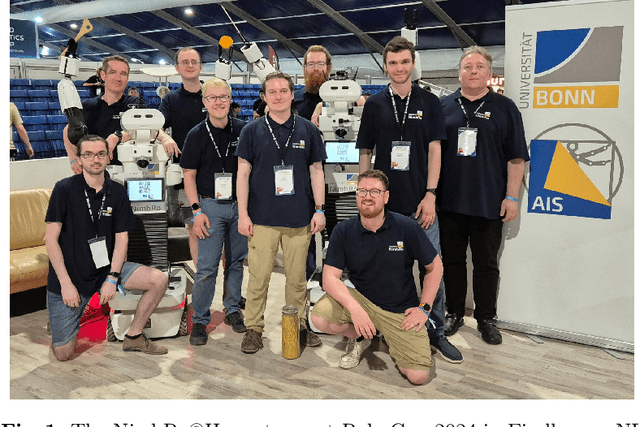
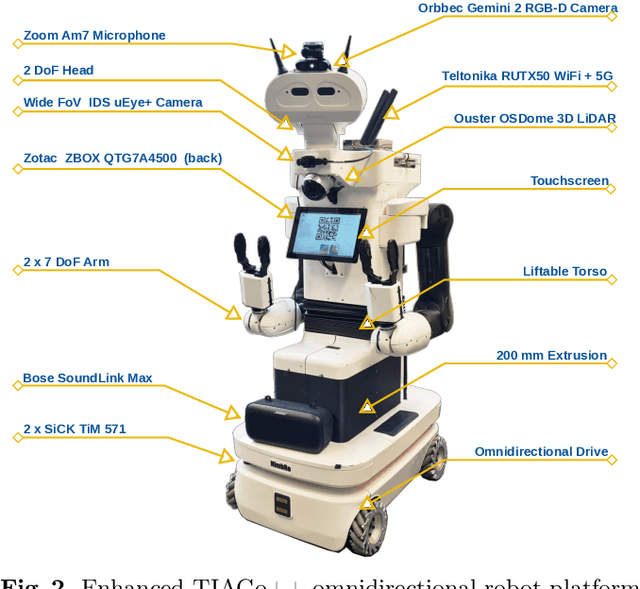


Abstract:We present the approaches and contributions of the winning team NimbRo@Home at the RoboCup@Home 2024 competition in the Open Platform League held in Eindhoven, NL. Further, we describe our hardware setup and give an overview of the results for the task stages and the final demonstration. For this year's competition, we put a special emphasis on open-vocabulary object segmentation and grasping approaches that overcome the labeling overhead of supervised vision approaches, commonly used in RoboCup@Home. We successfully demonstrated that we can segment and grasp non-labeled objects by text descriptions. Further, we extensively employed LLMs for natural language understanding and task planning. Throughout the competition, our approaches showed robustness and generalization capabilities. A video of our performance can be found online.
Person Segmentation and Action Classification for Multi-Channel Hemisphere Field of View LiDAR Sensors
Nov 17, 2024



Abstract:Robots need to perceive persons in their surroundings for safety and to interact with them. In this paper, we present a person segmentation and action classification approach that operates on 3D scans of hemisphere field of view LiDAR sensors. We recorded a data set with an Ouster OSDome-64 sensor consisting of scenes where persons perform three different actions and annotated it. We propose a method based on a MaskDINO model to detect and segment persons and to recognize their actions from combined spherical projected multi-channel representations of the LiDAR data with an additional positional encoding. Our approach demonstrates good performance for the person segmentation task and further performs well for the estimation of the person action states walking, waving, and sitting. An ablation study provides insights about the individual channel contributions for the person segmentation task. The trained models, code and dataset are made publicly available.
A Comparison of Prompt Engineering Techniques for Task Planning and Execution in Service Robotics
Oct 30, 2024Abstract:Recent advances in LLM have been instrumental in autonomous robot control and human-robot interaction by leveraging their vast general knowledge and capabilities to understand and reason across a wide range of tasks and scenarios. Previous works have investigated various prompt engineering techniques for improving the performance of \glspl{LLM} to accomplish tasks, while others have proposed methods that utilize LLMs to plan and execute tasks based on the available functionalities of a given robot platform. In this work, we consider both lines of research by comparing prompt engineering techniques and combinations thereof within the application of high-level task planning and execution in service robotics. We define a diverse set of tasks and a simple set of functionalities in simulation, and measure task completion accuracy and execution time for several state-of-the-art models.
Anticipating Human Behavior for Safe Navigation and Efficient Collaborative Manipulation with Mobile Service Robots
Oct 07, 2024Abstract:The anticipation of human behavior is a crucial capability for robots to interact with humans safely and efficiently. We employ a smart edge sensor network to provide global observations along with future predictions and goal information to integrate anticipatory behavior for the control of a mobile manipulation robot. We present approaches to anticipate human behavior in the context of safe navigation and a collaborative mobile manipulation task. First, we anticipate human motion by employing projections of human trajectories from smart edge sensor network observations into the planning map of a mobile robot. Second, we anticipate human intentions in a collaborative furniture-carrying task to achieve a given goal. Our experiments indicate that anticipating human behavior allows for safer navigation and more efficient collaboration. Finally, we showcase an integrated system that anticipates human behavior and collaborates with a human to achieve a target room layout, including the placement of tables and chairs.
Self-centering 3-DOF feet controller for hands-free locomotion control in telepresence and virtual reality
Aug 05, 2024



Abstract:We present a novel seated foot controller for handling 3-DOF aimed to control locomotion for telepresence robotics and virtual reality environments. Tilting the feet on two axes yields in forward, backward and sideways motion. In addition, a separate rotary joint allows for rotation around the vertical axis. Attached springs on all joints self-center the controller. The HTC Vive tracker is used to translate the trackers' orientation into locomotion commands. The proposed self-centering foot controller was used successfully for the ANA Avatar XPRIZE competition, where a naive operator traversed the robot through a longer distance, surpassing obstacles while solving various interaction and manipulation tasks in between. We publicly provide the models of the mostly 3D-printed feet controller for reproduction.
Cleaning Robots in Public Spaces: A Survey and Proposal for Benchmarking Based on Stakeholders Interviews
Jul 23, 2024Abstract:Autonomous cleaning robots for public spaces have potential for addressing current societal challenges, such as labor shortages and cleanliness in public spaces. Other application domains like autonomous driving, bin picking, or search and rescue have shown that benchmarking platforms and approaches in competitive settings can advance their respective research fields, resulting in more applicable systems under real-world conditions. For this paper, we analyzed seven semi-structured, qualitative stakeholder interviews about outdoor cleaning, identified current needs as well as limitations, and considered those results for the development of a benchmarking scenario based on the previous observations.
NimbRo wins ANA Avatar XPRIZE Immersive Telepresence Competition: Human-Centric Evaluation and Lessons Learned
Aug 28, 2023Abstract:Robotic avatar systems can enable immersive telepresence with locomotion, manipulation, and communication capabilities. We present such an avatar system, based on the key components of immersive 3D visualization and transparent force-feedback telemanipulation. Our avatar robot features an anthropomorphic upper body with dexterous hands. The remote human operator drives the arms and fingers through an exoskeleton-based operator station, which provides force feedback both at the wrist and for each finger. The robot torso is mounted on a holonomic base, providing omnidirectional locomotion on flat floors, controlled using a 3D rudder device. Finally, the robot features a 6D movable head with stereo cameras, which stream images to a VR display worn by the operator. Movement latency is hidden using spherical rendering. The head also carries a telepresence screen displaying an animated image of the operator's face, enabling direct interaction with remote persons. Our system won the \$10M ANA Avatar XPRIZE competition, which challenged teams to develop intuitive and immersive avatar systems that could be operated by briefly trained judges. We analyze our successful participation in the semifinals and finals and provide insight into our operator training and lessons learned. In addition, we evaluate our system in a user study that demonstrates its intuitive and easy usability.
Audio-based Roughness Sensing and Tactile Feedback for Haptic Perception in Telepresence
Mar 13, 2023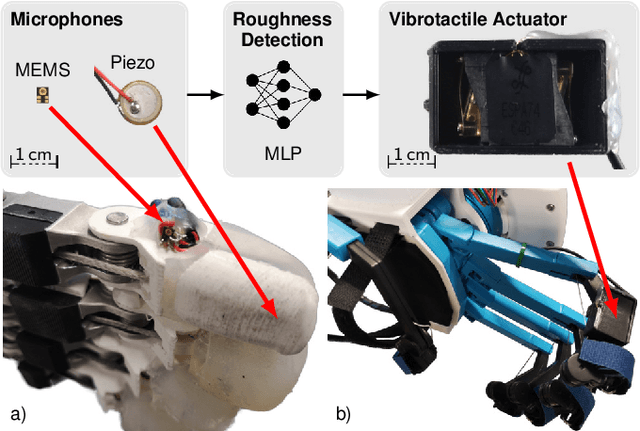

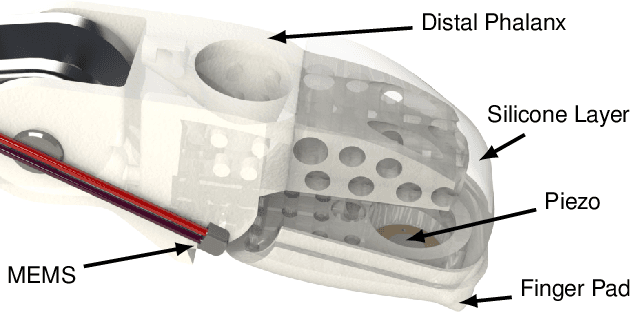
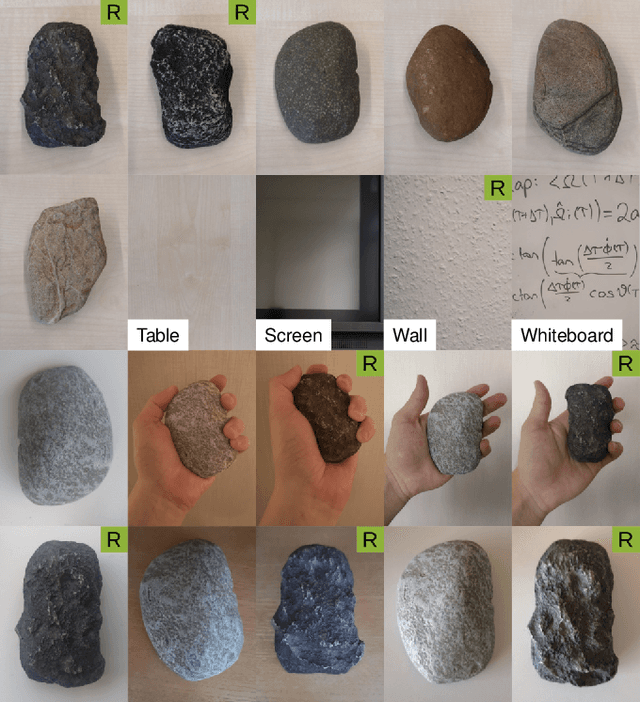
Abstract:Haptic perception is incredibly important for immersive teleoperation of robots, especially for accomplishing manipulation tasks. We propose a low-cost haptic sensing and rendering system, which is capable of detecting and displaying surface roughness. As the robot fingertip moves across a surface of interest, two microphones capture sound coupled directly through the fingertip and through the air, respectively. A learning-based detector system analyzes the data in real-time and gives roughness estimates with both high temporal resolution and low latency. Finally, an audio-based haptic actuator displays the result to the human operator. We demonstrate the effectiveness of our system through experiments and our winning entry in the ANA Avatar XPRIZE competition finals, where impartial judges solved a roughness-based selection task even without additional vision feedback. We publish our dataset used for training and evaluation together with our trained models to enable reproducibility.
External Camera-based Mobile Robot Pose Estimation for Collaborative Perception with Smart Edge Sensors
Mar 07, 2023Abstract:We present an approach for estimating a mobile robot's pose w.r.t. the allocentric coordinates of a network of static cameras using multi-view RGB images. The images are processed online, locally on smart edge sensors by deep neural networks to detect the robot and estimate 2D keypoints defined at distinctive positions of the 3D robot model. Robot keypoint detections are synchronized and fused on a central backend, where the robot's pose is estimated via multi-view minimization of reprojection errors. Through the pose estimation from external cameras, the robot's localization can be initialized in an allocentric map from a completely unknown state (kidnapped robot problem) and robustly tracked over time. We conduct a series of experiments evaluating the accuracy and robustness of the camera-based pose estimation compared to the robot's internal navigation stack, showing that our camera-based method achieves pose errors below 3 cm and 1{\deg} and does not drift over time, as the robot is localized allocentrically. With the robot's pose precisely estimated, its observations can be fused into the allocentric scene model. We show a real-world application, where observations from mobile robot and static smart edge sensors are fused to collaboratively build a 3D semantic map of a $\sim$240 m$^2$ indoor environment.
 Add to Chrome
Add to Chrome Add to Firefox
Add to Firefox Add to Edge
Add to Edge